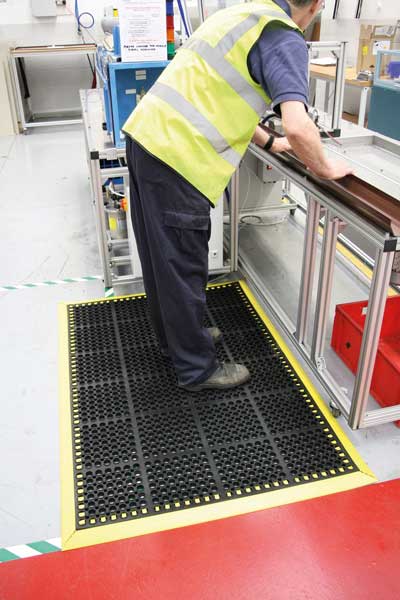
Creating an environment which supports the health and wellbeing of your employees is of utmost importance. Mark Chandler, product manager for site safety, storage and handling at Brammer Buck & Hickman, explains the role of anti-fatigue matting.
In manufacturing plants, it is common for workers to be standing for long periods. Though accepted as a basic characteristic of the role, this routine puts employees at risk of developing musculoskeletal disorders (MSDs) such as sore feet, swelling of the legs, muscle fatigue and lower back pain. Often a result of static loading which can affect muscles, tendons, ligaments, nerves and soft tissue, musculoskeletal disorders affect the movement of the body and can severely inhibit employees’ ability to carry out their work effectively.
In addition to the effect on workers’ lives, these conditions can be very costly for employers. Aside from compensation claims which are often made as a result of the thousands of work-related MSDs reported each year in the UK, productivity and output are also affected.
Straightforward measures such as the provision of more appropriate footwear can reduce the fatigue associated with standing for entire shifts, but more can be done to make workers comfortable. One solution – anti-fatigue matting – can improve the working environment for employees and minimise the negative effects of musculoskeletal disorders on productivity.
Standing on hard floor surfaces for the duration of work shifts puts people at greater risk of developing health issues associated with circulatory problems, such as varicose veins. These occur when the valves in the veins in the legs fail to close properly, allowing blood to flow backwards, causing increased pressure when standing and leading to the veins becoming enlarged. Similarly, constant muscle tension can lead to swelling and increase the pressure on nearby nerves. A few changes to their immediate environment can help to keep workers’ muscles moving throughout the day, to minimise the occurrence of these conditions.
By helping to replicate the action which naturally occurs during walking, anti-fatigue matting can help to avoid the damage which might otherwise occur to workers’ muscles. The slight movements might seem insignificant, but they make a big difference over the course of a work shift by encouraging the foot and calf muscles to expand and contract, promoting healthier blood circulation.
It is crucial to select the most effective matting for the specific environment. For instance, where conditions are wet or oily, some mats can also provide characteristics such as slip resistance. In settings where workers need to turn regularly, matting which uses more durable materials will provide a longer-lasting, more sustainable solution. Mats which are finished with a tough exterior surface – such as PVC or polyurethane – tend to be more resilient and can handle the pressures of more demanding environments.
Working with an experienced distributor such as Brammer Buck & Hickman and taking into consideration the nature of employees’ roles, employers can be sure that they are providing a working environment which minimises the health risks posed to their workforce.
For more information visit
www.buckandhickman.com

